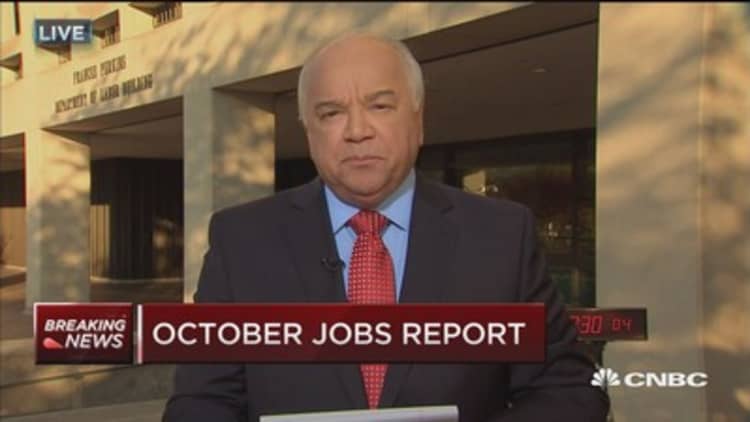
The U.S. economy added a less-than-expected 161,000 jobs in October and the unemployment rate stood at 4.9 percent as investors got to digest the final payrolls report before Tuesday's presidential election.
But the bigger number in the report could be wages, with average hourly earnings climbing 10 cents and reflecting a 2.8 percent annualized increase, according to the report from the Bureau of Labor Statistics. The number would seem to solidify a Fed rate increase in December, as the market has been expecting, though average weekly hours were flat at 34.4.
"The wage growth is something they've been looking forward to for a long time," said Dan North, chief economist at Euler Hermes North America, a trade credit insurance firm. The move from a 2.6 percent growth rate in September is "progress. That doesn't scream inflationary pressure, but it's going the right way."
Economists surveyed by Reuters had expected nonfarm payrolls to grow by 175,000 and the jobless rate to tick down to 4.9 percent. A broader measure of unemployment that includes those who have stopped looking for jobs and those working part-time for economic reasons fell to 9.5 percent, the lowest level since April 2008.
The number comes just four days before American voters choose another president. The hotly contested race between Donald Trump and Hillary Clinton added a new wrinkle to a report already closely watched in Wall Street circles. Trump has promised to bring jobs back from overseas, while Clinton has turned her focus to an aggressive infrastructure program and boosting wages for low-income workers.
"This number is in line with expectations and is unlikely to affect the results of the presidential election," said Brian Schaitkin, senior economist at The Conference Board.
Services set the pace for new jobs, adding 43,000 including 8,000 in computer systems design and related services, while health care grew by 31,000. Wall Street also saw benefit, with 14,000 more jobs in financial activities. Education and health services added 39,100 positions.
The household survey painted a less-flattering picture, with full-time jobs falling by 103,000 and part-time positions gaining 90,000, while and government reported a 22,000 net gain.
The level of workers counted as out of the labor force was the second highest on record, surging 425,000 to 94.6 million. And the labor-force participation rate also edged lower to 62.8 percent and remains mired around levels last seen in the late-1970s.
On the downside, retail positions fell by 1,100 heading into the holiday season, while manufacturing lost 9,000 and mining and logging dropped 2,000.
"Unfortunately, manufacturing job growth remains virtually non-existent," said Mark Hamrick, senior economic analyst at Bankrate.com. "Many of those separated from this sector for a long time, perhaps lacking sufficient meaningful skills to get back into the workforce, feel like their government has forgotten them."
At the same time, Hamrick said the wage growth was "money in the bank for workers feeling like they've been waiting a long time for this piece of the economic recovery puzzle to be added. There's more work to do in the wages and incomes department, but this is good to see nevertheless."
Previous months showed upward revisions to the jobs numbers. August went from 167,000 to 176,000 and September's disappointing 156,000 climbed to 191,000, bringing the three-month average to 176,000. 2016 has seen average job gains of 181,000, a drop-off from the 229,000 in 2015.


